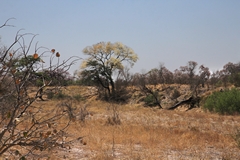
This is the Savuti channel near to the marsh.
As you can see it is bone dry and has been
since 2015. Nobody can predict when it will
flow again
Savuti (also spelled Savute) is a 5000 km2 area of Chobe which has the Okavango Delta to the west and the Chobe National Park to the east and is a well known area of Botswana, often used for TV documentaries about wildlife, particularly lions. You can see it's position on the Savuti map.
Savuti is famous for the 'river' which sometimes flows and sometimes dries up, known as the Savuti channel. It runs a distance of 100 kilometers from the from Zibadianja Lagoon on the Chobe River, through a gap in the sand ridge, to the Mababe Depression. Its overall fall is only 18 metres en route. Where it ends near the Mababe depression it creates what is known as the Savuti marsh.
At least, it does when it flows. Periodically and for many years at a time the channel stops flowing and dries up completely. It flowed – with a year’s break – between 1957 and 1982, whereupon it once again ran dry. Then it started flowing again in 2008 and reached the 'marsh' by 2010. But then in 2015 it ran dry again.
It is thought to start and stop due to tectonic activity near to where it leaves the Chobe river. Some movement in the faults in the area affect its ability to flow
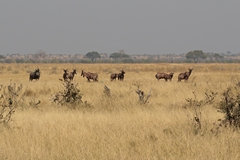
These Tsessebe are on the edge of the area
known as the Savuti marsh. You can see, at
this time of year it is more of a dry grass
savannah, reminiscent of the treeless plains
of the southern Serengeti
The marsh isn't a true marsh at all, In fact in September it is an open, treeless, dry, long grassy area, with no surface water on it. When the rains arrive it is transformed into lush green but since the channel isn't currently flowing it is now very seasonal.
Savuti was once thought to be submerged under a huge inland 'sea', with the Upper Zambezi, Chobe and Kavango rivers joining into a single river that flowed into it from the north. The 'sea' formed when earlier geological activity stopped the rivers from continuing their original course south towards the Limpopo. But then further tectonic activity caused faults which lifted the land and stopped the rivers from even flowing into the huge lake, and they changed course to the north east towards what is now the Victoria falls. The lake was left with no inflow because the Okavango could not reach it either and the water evaporated until the area returned to desert like conditions.
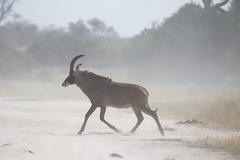
Savuti is very dry and dusty and most of the
surface soil is sand, which you might expect,
as it is part of the Kalahari basin. It is also
home to a population of roan antelope
Consequently much of the wildlife migrates north or south in the dry season, although there are still good numbers of game present. I saw only a very few buffalo and no zebra there in early September. However there were plenty of wildebeeste, impala, kudu, giraffe, tsessebe, warthogs, elephants and predators, including lions, leopards, cheetah and wild dogs.
Birdlife is abundant, particularly starlings and francolins, but also hornbills, secretary birds and kori bustards.
The region is mostly covered with extensive savannahs and rolling grasslands, with a couple of rocky outcrops thrown in to add a bit of scenic interest. Much of the area is characterised by Camelthorn sandveld, Silver Terminalia, scrub savannah, and mopane veld. The pink flowers of Kalahari apple-leaf trees stand out at this time of year.
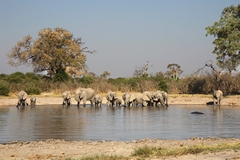
These waterholes are the lifelines of Savuti
in the dry season. Without them much more
of the wildlife would leave the area
Rains arrive from November till April, at which time the animals make their way back to pastures rich in new grass. Sometime in November or December thousands of zebras migrate from the Linyanti in the north and move south through Savuti to the grasslands of the Mababe Depression. In February they start heading northwards again. Annual average rainfall levels are 640 mm, with January and February being the wettest months.
From May to October the water pans dry up and the animals are attracted to several artificial waterholes. These are maintained by pumping water into them from boreholes. Large herds of elephants congregate here in the afternoons and provide endless entertainment.
In September Savuti can start to warm up fast and get to be extremely hot. Temperatures of 40 C are not uncommon. October and November get even hotter. However because the area is essentially subject to a desert type climate, at night the temperatures plummet and by early morning can be close to freezing between June and September.
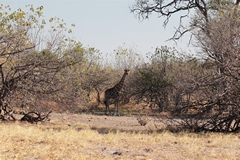
Away from the main 'roads' you can get away
from it all and relax in the tranquility. Giraffes
and Kudus are plentiful in these sort of areas
To me this is one of the big downsides of safari in Botswana. It is difficult to sit out in the evening without a coat on, it can be hard to keep warm overnight and in the early mornings the game drives can feel very cold. In the mid day heat between safaris the temperature in a tent can be unbearably hot. As a consequence of this it makes packing a light bag for internal flights even more of a difficult choice. East Africa has a much more benign climate.
Savuti roads, mainly the western Sandridge Road from Mababe Gate and the roads both north and south of the Savuti channel are typically thick sand and tricky to drive.
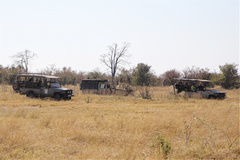
Cars tend to crowd big cat sightings. What
makes it worse is people chattering and
calling between cars. It spoils both the mood
and the sighting
One of the worst things about this area was the fact that there is a lot of tourist traffic. As a result it tends to become a matter of spotting the clumps of up to ten or so cars stopped, and driving over to see whatever they are looking at (usually cats). There are a lot of completely unethical self drivers on the roads as well, who can also spoil the experience of being in such a remote location. There seems to be little policing of rules, such as not going off road, both by these people and professional guides as well.
Away from the big cats however, the area is usually very quiet and if, like me, you are interested in all animals, common or not, it is quite easy to find some lovely tranqil sightings. Giraffes and kudu for instance tend to be seen in the more thicker bush areas, and the backgrounds make for good atmospheric photographic images.
Another point of interest is that there were lots of different mongooses about and I managed to get close to a slender mongoose and a yellow mongoose amongst others.
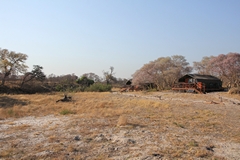
The tents in Camp Savuti are set amongst
the Kalahari apple leaf treees, and face
the dry channel, which is marked by the high
bank crossing left to right along the centre of
this photo
Overall, Savuti is great for photography with lots of easy to find animals. It is a very good area for predators and especially leopards and painted wolves. Lions too, but then lions are easier to find everywhere. The experience is somewhat marred by some inconsiderate members of the public and also the lack of standards of the professional drivers. It may be better to be based in one of the adjacent private reserves such as Linyanti, but of course costs have to balanced against this.
Botswana is facing some difficult issues due to its 130,000 elephant population. They are destroying a lot of mopane and other trees, although I have seen mopane regenerate very frequently. Also they have expanded their range further south in recent years and are coming in to conflict with farmers more often. One reason for this may be that they know they aren't safe from hunters guns if they go north into Namibia or Angola or Zambia. Studies have shown they tend to stay in Botswana all year rather than crossing the borders as they used to. Perhaps a ban on hunting in these countries would encourage them to take their traditional routes.
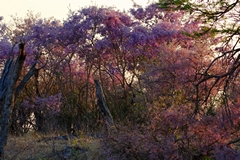
Early morning sunshine lights up the blossom
of the Kalahari Apple leaf trees They thrive on
the sandy soil in the area
There has been a big increase of poaching in Botswana recently, despite the excellent job done by the Botswana Defence Force and park rangers. It is nothing like East Africa, but needs to be carefully monitored.
Trophy hunting of elephants has been reinstated as of mid 2019. Trophy hunters have swayed the government in favour of resuming it as a response to Human Wildlife Conflict. However, they don't target the crop raiding elephants specifically, just pick one of the bulls in the area with bigger ivory and shoot it. How this stops crop raiding in any way baffles me. But then again, I don't suppose they actually want it to stop.
As a conservation measure it is nonsense, and only serves to diminish the quality of the gene pool, but this is the way the new government is going forward (or should I say backwards).